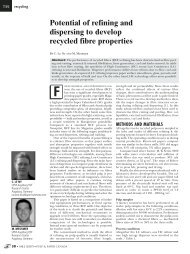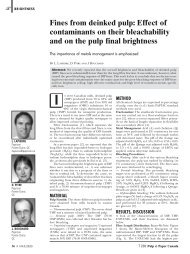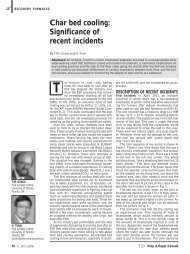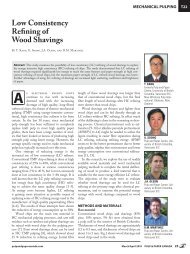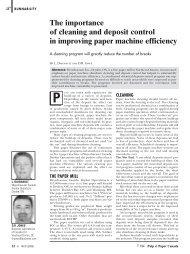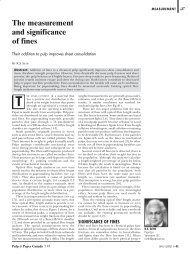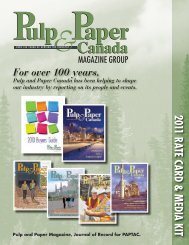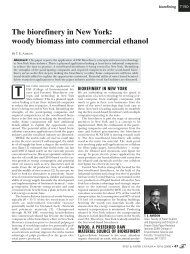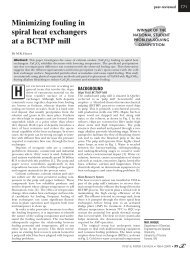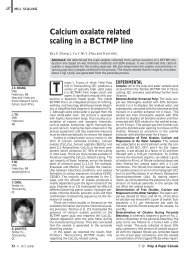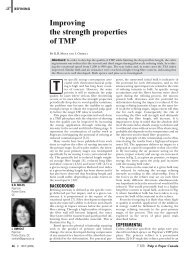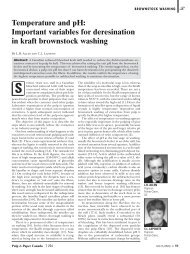Compact wet end systems for superior papermaking
Compact wet end systems for superior papermaking
Compact wet end systems for superior papermaking
Create successful ePaper yourself
Turn your PDF publications into a flip-book with our unique Google optimized e-Paper software.
WET ENDFIG. 5. Flexible cascade cleaner arrangement.with higher flow velocities than a conventional white water system.There<strong>for</strong>e, bacteria growth and scale build-up are minimized.Flexible cleaner arrangementAs an additional volume reduction opportunity, compact <strong>wet</strong><strong>end</strong> <strong>systems</strong> can incorporate a cleaner arrangement that reducesequipment sizing and energy cost while further reducing systemvolume. This system is shown in Figure 5.The primary cleaners of the flexible cascade arrangement aresized <strong>for</strong> minimum headbox flow or optimum cleaning efficiency.Here, secondary accepts are recirculated in a full cascadearrangement. As headbox flow increases, secondary accepts feed<strong>for</strong>ward automatically <strong>for</strong> an open cascade operation to satisfythe higher flow requirement. When flow requirements exceedthe combined primary and secondary accepts flow, additionalwhite water dilution flow is drawn from the distribution header.Cleaners of the “Flexible Cascade” arrangement operate at optimumflow or cleaning efficiency throughout a broader range of theheadbox flow. Equipment selections are minimized, horsepowerrequirements are reduced and control and piping <strong>systems</strong> are simplified.<strong>Compact</strong> seal pitThe flat box or vacuum leg seal pit is often overlooked as an areaof the <strong>papermaking</strong> process requiring improvements orupgrade. For compact <strong>wet</strong> <strong>end</strong> <strong>systems</strong>, it provides anotheropportunity to reduce system volume and improve papermachine per<strong>for</strong>mance.Typical, seal pit operations are dirty, turbulent, large volumechest that can generate vacuum variations at the <strong>for</strong>ming section.In addition, slime buildup can be difficult to manage leading toincreased frequency of required thermal, mechanical and/orchemical cleaning. With the compact <strong>wet</strong> <strong>end</strong> system approach,a compact, pre-fabricated seal pit is provided. See Figure 6.This unit allows each vacuum leg to be sealed individuallyand operators can view the per<strong>for</strong>mance of each table elementand make adjustments as may be necessary. The individual sealchambers can be easily fitted with a “V-notch weir” to allow directand simple flow measure and sampling from each vacuumdevice. Figure 7, is an operating compact seal pit unit.RESULTSAfter the first compact <strong>wet</strong> <strong>end</strong> system startup in 1997, it becamequickly apparent that per<strong>for</strong>mance and additional opportunities<strong>for</strong> improvement would be much greater than anticipated. Benefitsthat have been reported to date include:• 60% reduction in grade change time• 75% reduction in <strong>wet</strong> <strong>end</strong> breaks• 50% reduction in wash-up frequency• 25% reduction in energy consumption• 20% improvement in sheet <strong>for</strong>mation• 99.5+% “air-free” white water• 10% operating efficiency improvementFIG. 6. <strong>Compact</strong> seal pit.FIG. 7. Operating compact seal pit.A discussion of these improvements and opportunities [5]include:Reduced grade change timePaper machines incorporating compact <strong>wet</strong> <strong>end</strong> <strong>systems</strong> havereduced grade change time on average by 60%. Reduced processvolumes allow thick stock and white water <strong>systems</strong> to purgequickly, minimizing off-quality production and transition time.The improvements in change time apply to simple basisweight changes or complete color and/or <strong>wet</strong> <strong>end</strong> chemistrychanges. One installation reported simple basis weight changeswere improved by 65% where a color producer reduced gradeto-gradechange time by greater than 80%. Many specialtymachines find downtime <strong>for</strong> wash-up between grade changes areno longer required and major production changes are nowmade on the fly.Reduced <strong>wet</strong> <strong>end</strong> breaks<strong>Compact</strong> <strong>wet</strong> <strong>end</strong> <strong>systems</strong> have disproved the age-old assumptionthat large volume processes are required <strong>for</strong> maintaining astable system. Whether in thick stock or white water <strong>systems</strong>,large volume <strong>systems</strong> can generate low frequency variations thatare difficult if not impossible to attenuate. These variations usuallycontribute to significant MD weight swings.With the minimum retention time in a compact stock mixerand the higher flow velocities of the hydraulic white water distributionsystem, low frequency variations are avoided. The elevatedoverflow head tank further enhances the white water <strong>systems</strong>tability with the optimum in pressure control <strong>for</strong>minimizing variability.Stable white water <strong>systems</strong> are the key to a stable <strong>wet</strong> <strong>end</strong>. One30 ❘❘❘ 105:4 (2004) T 85 Pulp & Paper Canada
WET ENDcompact <strong>wet</strong> <strong>end</strong> system installation reportedan 80% reduction in <strong>wet</strong> <strong>end</strong> breaksdue to improved stability. Other users noteMD variation reduced significantly withtwo sigma reductions of up to 50%.Reduced wash-up frequencyWhite water system cleanliness is affectedby flow velocities and entrained air content.Wire pits and silos maintain low flowrates by design, allowing stagnant areas toexist which support bacteria growth. Air inthe white waters further enhances bacteriagrowth requiring use of biocides, slimicidesand defoamers <strong>for</strong> control.<strong>Compact</strong> <strong>wet</strong> <strong>end</strong> <strong>systems</strong> removeentrained air immediately on exiting the<strong>for</strong>ming section; there<strong>for</strong>e air is not introducedto the downstream system. Also,high flow velocities in the hydraulic whitewater system prevent stagnate areas anddirt accumulation. Each of these contributesto improved system cleanlinesswith a compact <strong>wet</strong> <strong>end</strong> system.The improved cleanliness reduces boilout frequency and chemical additionsneeded <strong>for</strong> bacteria and slime control.The boil out frequency on one machineimproved by 50%; 6 week cycles <strong>for</strong> systemboil outs was increased to 12 weeks with acompact <strong>wet</strong> <strong>end</strong> system. Chemical usagewas also reduced with defoamer consumptiondown by 50% and biocidereductions of 75%. Boil out chemicalrequirements are less with the reducedvolumes and boil outs are more effective.Reduced energy consumptionMany components of conventional <strong>wet</strong><strong>end</strong> <strong>systems</strong> can be eliminated with a compactsystem. Bl<strong>end</strong> and machine chests,white water wire pits, silos, vacuum deaeration<strong>systems</strong> and water storage tankshave been deleted.The elimination of these componentshas resulted in energy savings of up to25%. Combined with these savings is theincreased efficiencies gained from thepressurized white water distribution system.Here, the distribution system supplieswhite water to all system users athigher suction pressures <strong>for</strong> increasedpump per<strong>for</strong>mance and improved pumpingstability.Improved sheet <strong>for</strong>mationRemoving air from the short circulationwhite waters increases drainage in the<strong>for</strong>ming section. With increased drainage,lower headbox consistencies can beobtained. Lower headbox consistencieswill improve <strong>for</strong>mation and there<strong>for</strong>equality. All compact <strong>wet</strong> <strong>end</strong> system usersreport improved <strong>for</strong>mation and in onecase slice flows were increased by 20%.Air-free white waterThe management of entrained air in the <strong>wet</strong><strong>end</strong> white waters is critical with compact <strong>wet</strong><strong>end</strong> <strong>systems</strong>. Centrifugal deaeration hasproven to be effective in removing entrainedair from the short circulation waters. The virtuallyair free white waters produced by thesecentrifugal deaeration units rival moreexpensive vacuum <strong>systems</strong>.One compact <strong>wet</strong> <strong>end</strong> installationreplaced their vacuum deaeration systemwith centrifugal deaeration <strong>for</strong> equal to betterresults. Other installations reportentrained air levels as low as 0.1%.Improved operating efficiencyEach of the above results from currentlyoperating compact <strong>wet</strong> <strong>end</strong> <strong>systems</strong>improve paper machine operating efficiency.Combined, they can significantlyreduce bottom line cost. To date, compact<strong>wet</strong> <strong>end</strong> system users have reported overallefficiency improvements of 2.5% up tomore than 10% as compared to earlieroperation with conventional <strong>systems</strong>.CONCLUSIONOf the many compact <strong>wet</strong> <strong>end</strong> <strong>systems</strong> inoperation to day, no installation has electedto go back to the old (conventional)way of operating the <strong>wet</strong> <strong>end</strong> of theirpaper machine. Once the magnitude ofthe benefits has been realized, the operatingunits only look <strong>for</strong>ward to additionalopportunities.Many different grades employ compact<strong>wet</strong> <strong>end</strong> <strong>systems</strong> including coating basestock, specialty fine papers, decorativelaminates, core stock, photographicpaper, recycled linerboard and medium.<strong>Compact</strong> <strong>wet</strong> <strong>end</strong> <strong>systems</strong> improvepaper machine <strong>wet</strong> <strong>end</strong> operation as com-pared to conventional large volume <strong>systems</strong>.Utilizing compact stock mixing,white water centrifugal deaeration andpressurized white water distribution <strong>systems</strong>,<strong>wet</strong> <strong>end</strong> processes are extremelyresponsive to operational demands whilemaintaining stable operations.With deaeration of white waters immediatelyoff the <strong>for</strong>ming section, <strong>systems</strong>operate much cleaner than conventionalones and pulsations from air in the processare avoided. The pressurizedhydraulic white water distribution systemprovides segregation of rich verses leanwhite waters <strong>for</strong> 100% recycle of richwaters. Only the leanest water flows toexcess significantly reducing system losesto sewer.<strong>Compact</strong> <strong>wet</strong> <strong>end</strong> <strong>systems</strong> have been successfullyapplied <strong>for</strong> new greenfield installationsas well as cost-effective alternatives toconventional upgrade options. When consideringyour next upgrade or a new installation,compact <strong>wet</strong> <strong>end</strong> <strong>systems</strong> should not beoverlooked. This proven, reduced volumeapproach has established itself as the futurein paper machine <strong>wet</strong> <strong>end</strong> technology.LITERATURE1. Meinander, P.O. An Approach To Just On TimePapermaking. TAPPI Paperrmakers Conference,CITY, PROV (MONTH, 1993).2. Meinander, P.O., Olsson, L-H. <strong>Compact</strong>, Airless WetEnd Systems. TAPPI Proceedings, TAPPI Press: 1213-1218 (MONTH, YEAR).3. Meinander, P.O. Apparatus and Process <strong>for</strong> FeedingStock to a Paper Machine. PCT patent applicationPCT/FI96/00052 (January 25,1996).4. Helle, T-M., Meinander, P.O., Paulauro, H. Removalof entrained air from white water by application ofcentrifugal <strong>for</strong>ce. Paper and Timber 80(5): 379-382(MONTH, YEAR).5. Meinander, P.O., Cutts, J., Kontkanen, M., Nykanen,R. Experience Confirms the Validity of <strong>Compact</strong> WetEnd Systems. TAPPI Papermakers Conference, CITY,PROV (MONTH, YEAR).Résumé:Les systèmes compacts pour la partie humide ont permis d’améliorer de jusqu’à 10 % le gain der<strong>end</strong>ement de la machine. Grâce aux systèmes compacts pour la partie humide, les fosses soustoile, les silos et les systèmes de désaération mécanique sont éliminés, ainsi que les cuviers demachine et de mélange de la pâte épaisse. Une réduction de jusqu’à 90 % du volume à la partiehumide a été obtenue. La présente communication discute des principes et de l’exploitation dessystèmes compacts à la partie humide. Des applications particulières sont évaluées et font l’objetde discussion.Reference: Paper presented at the 88th Annual Meeting in Montreal, QC, Canada, January 28-31, 2002. Not to be reproduced without permission of PAPTAC. Manuscript received November16, 2001. Revised manuscript approved <strong>for</strong> publication by the Review Panel on June 6, 2002Keywords: PAPER MACHINES, WET ENDS, MACHINE DESIGN, PERFORMANCE EVALU-ATION,Pulp & Paper Canada T 86 105:4 (2004) ❘❘❘ 31



